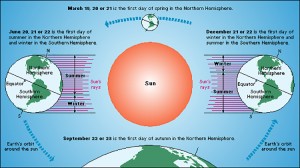June Solstice
June 21, 2016

When the North Pole has its greatest slant toward the sun, left, summer begins in the Northern Hemisphere and winter begins in the Southern Hemisphere. Credit: WORLD BOOK map
Have you noticed that the days have been getting longer and longer (or the reverse, if you live in the Southern Hemisphere)? The increasing difference between day and night reached its peak yesterday at 22:34 Coordinated Universal Time. This moment is called the June solstice.
A solstice is one of the two moments each year when the sun is at either its northernmost or southernmost position in Earth’s sky. Earth’s axis of rotation is tilted at an angle of 23 degrees 27 minutes in relation to the plane of Earth’s orbit around the sun. As Earth orbits the sun, the angle of tilt points toward the same direction in space. Thus, the direction of this angle in relation to the sun changes throughout the year, causing seasons on Earth.
Solstices mark the beginnings of astronomical summer and winter. In the Northern Hemisphere, the June solstice marks the longest day of the year. In the Southern Hemisphere, yesterday was the shortest day of the year and signaled the arrival of astronomical winter. Now, the day and night will get closer to the same length until the next equinox in September. During an equinox, the tilt of Earth’s axis lies such that neither hemisphere is angled toward the sun. This means that each part of Earth receives the same amount of daylight, so day and night are roughly the same length.
Cultures around the world, but especially those in higher latitudes in the Northern Hemisphere, celebrate the June Solstice. For example, the people of Sweden celebrate Midsummer’s Eve and Midsummer’s Day around the time of the June Solstice. Solstices were also important to ancient people. Thousands of years ago, people living in what is now southwestern England built Stonehenge, a circle of large carved stones. Several features of Stonehenge align with the sun on solstices, suggesting that they were important to its builders.


